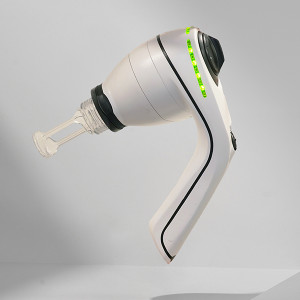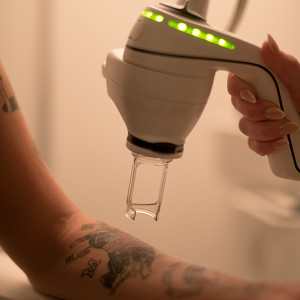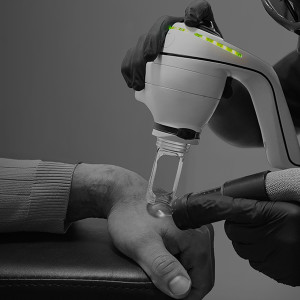
Laser tattoo removal is the most successful way to get rid of unwanted tattoos. Read on to see how the process works.
Tattoo removal is the most effective way to get rid of unwanted tattoos. The process uses laser technology to break down the tattoo ink into small particles, which are then eliminated by the body's immune system. The body's natural healing process then helps to remove the broken-down ink particles.
Although there are some potential risks and side effects, such as scarring or changes in skin pigmentation, picking the right laser will ensure the treatment is safe and a great option for anyone looking to remove a tattoo.
One of the benefits of laser tattoo removal is that it is generally safe and effective. The laser only targets the tattoo ink, so it does not damage the surrounding skin.
Publish Date in article


How the process works
To begin the tattoo removal process, a trained medical professional will first clean the area around the tattoo to remove any dirt or bacteria. They will then use a specialised laser device to deliver short pulses of focused light to the tattooed area. The laser light is absorbed by the tattoo ink, causing it to break down into smaller particles. The body can finally process these particles in their smaller size, and flush them out of the body.
As the LightSense™ laser system breaks down the tattoo ink, it also heats up the surrounding skin. This heating action helps to stimulate the body's natural healing process and encourages the immune system to remove the broken-down ink particles.
The body will continue to eliminate the broken-down ink particles over the next several weeks, and multiple treatments may be needed to fully remove the tattoo.




What’s the best tattoo removal laser?
The specific type of laser used for tattoo removal depends on the colours of the tattoo ink. Different colours of ink absorb different wavelengths of light, so a different laser may be used for each colour. For example, black and blue ink were often treated with Q-switched Nd:YAG laser, while red and orange ink would have required a different type of laser, such as a Q-switched ruby laser.
Today, the LightSense™ laser system—available exclusively at NAAMA—is the leading laser to remove both black and coloured inks. It effectively breaks down the ink pigments faster, without causing unnecessary harm to the skin. With less downtime required to heal between sessions, clients can come in more frequently for treatments and see better results in less time.
Clients love LightSense™ for:
- How gentle it is. The laser uses lower energy to effectively remove ink pigment without over-blasting the surrounding skin or causing unnecessary harm to the tissue.
- No long term skin damage. According to NAAMA’s data, fewer than 1% of clients blister after treatment.
- How fast the results are. Because there is less time needed to heal between treatments, you can come in every 2-3 weeks and see results sooner.

Results after just 9 sessions. The skin is clear, smooth and in healthy condition. See more tattoo removal before and afters here.

How long does tattoo removal take?
How long your tattoo removal will take and the number of laser tattoo removal treatments needed to fully remove a tattoo can vary depending on several factors, including the size and colour of the tattoo, the age of the tattoo, and the type of ink used. It can take several treatments and sometimes years to fully remove a tattoo if the laser technology is older.
With NAAMA’s LightSense™ technology, treatments are faster, more precise and much kinder to the skin. Permanent makeup can take 3-5 sessions to remove whereas tattoos can take anywhere from 8-12, sometimes less and sometimes more, depending on how the body responds to treatment.
The most cost-effective way to treat is to purchase a session package. Explore NAAMA's tattoo removal packages here.
Why are other tattoo removal methods ineffective?
Other methods, like dermabrasion and saline tattoo removal, can be painful and can cause scarring. They're not very effective at removing tattoos and can even cause serious side effects. Chemical peels, cryotherapy, and excision are some of the methods used, but they can cause complications and are not as effective as laser removal.
Here’s why we don’t recommend them:
- Chemical peels involve applying a chemical solution to the tattooed area, which causes the top layers of skin to peel off. It’s incredibly painful and often leads to irreversible skin damage.
- Cryotherapy involves freezing the tattooed area with liquid nitrogen. Oftentimes the treatment is painful and can cause scarring.
- Excision involves cutting out the tattooed skin and stitching the wound closed. This can lead to infections, long healing time and scars.
Final thoughts…
If getting rid of your unwanted tattoos is a priority for you, laser tattoo removal is definitely the safest and most effective way to get the job done. Any other method is time consuming, offers inconsistent results and can really damage the skin. NAAMA's leading laser technology is the best tattoo removal laser available and is the safest on the skin. Speak to one of our experts to begin your journey today.
For trends in breakthrough laser tattoo removal technology, here are NAAMA's top FAQs.
What is the best laser for tattoo removal?
What is the newest laser technology for tattoo removal?











